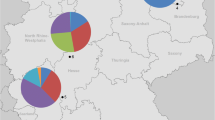Abstract
The problems discussed are concerned with the relations between the size of the females and their clutch size of this species by investigation of a great number of mosquitoes out of the open land and their clutch of eggs obtained in the laboratory. It was found a relation between the size of the females and the number of their eggs deposited. These problems were regarded in connection with different factors e. g. air temperature, temperature in the breeding biotopes during the active period of the imagines in each single month and relation to the ratio of size of females and the clutch of every size category. The results obtained concerning the ratio of size of the females and the clutch atAnopheles m. messeae show a series of agreements on principle with results relating obtained by the author withAnopheles claviger (Meigen, 1804).
Zusammenfassung
Die Untersuchung mehrerer tausend im Freiland gesammelter Mücken vonAnopheles messeae messeae Falleroni und ihrer im Labor abgelegten Eier ergab eine Bezichung zwischen Weibchengröße und Zahl abgelegter Eier: Die mittlere Eizahl pro Gelege nahm mit der Körpergröße der Weibchen zu. Dieser Befund ist von praktischer Bedeutung, da er an Hand einer gesammelten Teilpopulation eine Prognose der zu erwartenden Nachkommenzahl (unter Ausschluß dichtesenkender Umweltfaktoren) ermöglicht.
Similar content being viewed by others
Literaturverzeichnis
Detinova, T. S., 1962: Age-Grouping, Methods. In: Diptera of Medical Importance. World Health Organiz. Monogr. Ser. No. 47, Geneva.
Kühlhorn, F., 1954: Beitrag zur Verbreitung, Ökologie und Biologie der Fiebermücken in Süd-Niedersachsen. Beitr. z. Naturk. Niedersachsens7, 12–21.
Kühlhorn, F., 1962: Dipterologische Studien in Niedersachsen. I. Über Anopheles-Vorkommen (Diptera: Culicidae) und die Milieuverhältnisse verschiedener Brutbiotope im Raum Göttingen-Northeim. Beitr. z. Naturk. Niedersachsens15, 84–104.
Kühlhorn, F., 1963: Populationsdynamische Untersuchungen beiAnopheles messeae Fall. undAnopheles claviger Meig. (Dipt.: Culicidae) in Oberbayern. Z. angew. Zool.50, 311–327.
Kühlhorn F., 1964: Über das Größenverteilungsverhalten der Weibchen vonAnopheles claviger Meig. im Zusammenhang mit den Temperaturverhältnissen während der Entwicklungszeit in einem oberbayerischen Untersuchungsgebiet. D. Ent. Z. N. F.11, 413–428.
Kühlhorn, F., 1972: Fortpflanzungsbiologische Studien beiAnopheles messeae messeae Fall. (Diptera: Culicidae). Z. Angew. Entomol.70, 187–203.
Author information
Authors and Affiliations
Additional information
Mit 2 Abbildungen und 4 Tabellen
Mit Unterstützung der Deutschen Forschungsgemeinschaft.
Rights and permissions
About this article
Cite this article
Kühlhorn, F. Weibchen- und Gelegegröße bei Anopheles messeae messeae Falleroni 1926 (Diptera, Culicidae). Anz. Schadlingskde., Pflanzenschutz, Umweltschutz 54, 151–155 (1981). https://doi.org/10.1007/BF01907701
Issue Date:
DOI: https://doi.org/10.1007/BF01907701




